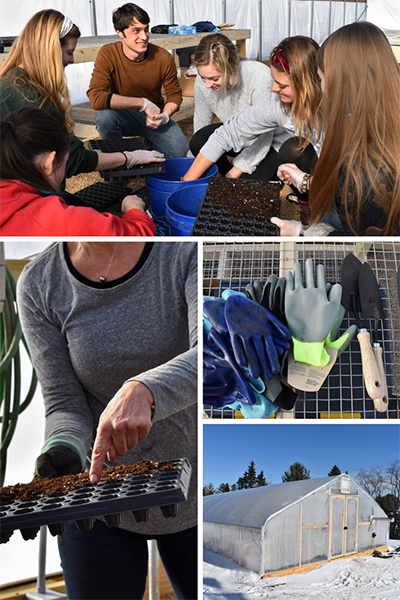Hoop House Offers Students Experience, Fresh Food Options
Students in the Environmental Studies program can now apply their lessons in homesteading and sustainability in a newly built greenhouse—or its proper term, hoop house. The steel-framed, tented tunnel was built on the university grounds near Torvian Dining Hall—a fitting location, as the Torvian chefs will soon be cooking with the fresh produce grown inside the modern structure.
Dr. Lauri Chose, Director of the Environmental Studies program, is looking forward to the many opportunities the hoop house will provide for her students. “It allows us to work with our growing seasons instead of against them, thereby teaching students that we are using our natural resources wisely to eat foods that are grown locally and in season. This is important to us because it really reflects the sustainable messages we are trying to spread at SFU.”
Like a traditional greenhouse, the hoop house protects crops from the elements in an effort to extend the growing season. The difference is that a greenhouse creates its own environment using external heating and cooling systems, whereas a hoop house works with the elements of the season, relying primarily on solar heat and natural ventilation.
Students in Professor Marie Olson’s Sustainability in Food Production course have started seedlings, and will soon plant them into the freshly spread soil. The class will manage and oversee all crop growth throughout the spring semester.
“Students will be able to get their hands dirty and be the participants in this exciting and rewarding endeavor,” said Olson. “They will also have the opportunity to learn the how and why of a paradigm shift in food production that works with nature instead of against it.”
The benefit of using a hoop house over a greenhouse, Olson says, is the minimal input required and the techniques used. Soil will be built with manure, and will not require tilling during crop rotation. External heating will be used only to prevent frost during cold seasons and at night. The temperature during the day will sufficiently heat the interior of the tented structure.
Crops such as lettuce (mache, arugula, mesclun, romaine) spinach, kale, swiss chard, tatsoi, pak choi, radishes, carrots, beets, sugar snaps, and onions will be planted, along with select herbs and flowers. The ripe produce will then be sold to Torvian Dining Hall, providing fresh, locally grown food options for the university. The first harvest is expected in March, midway through the semester.
The Environmental Studies program plans to use the hoop house as an ongoing teaching tool for students and a healthy food source for the university.
To contribute to the Hoop House or future projects like this, contact the Office of Advancement at 814-472-3021, or donate online here.
